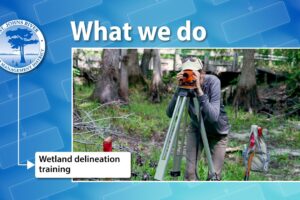Searching for elusive skunks and weasels on District lands
A Florida Fish and Wildlife Conservation Commission (FWC) researcher is hoping a scat-sniffing dog will help her learn more about elusive long-tailed weasels and spotted skunks on St. Johns River Water Management Districts lands.
“Historically, long-tailed weasels and spotted skunks were widespread in Florida,” says Lisa Smith, an FWC research associate who launched her pilot project in the fall of 2020. “Unfortunately, they’re disappearing in the Southeast and they’re not getting any attention.”
Smith is conducting her search on several District properties, including Dunns Creek Conservation Area in Putnam County and Newnans Lake and Lochloosa Wildlife conservation areas in Alachua County. The District buys and manages land as part of its mission to protect and preserve water resources. These lands also protect plant and wildlife habit, offering other agencies, such as FWC, opportunities to study rare and endangered animals.
In Florida, long-tailed weasels (Mustela frenata) were once found throughout most of the state. However, since 1993 there have been only seven confirmed sightings of them. Similarly, the eastern spotted skunk, (Spilogale putorius) is another seldom seen mesomammal whose status is poorly known. Much like the long-tailed weasel, the eastern spotted skunk was once common throughout the midwestern and southeastern United States before their population crashed to 10 percent of their previous numbers in the 1940s, never fully recovering. Habitat change, extensive pesticide use, disease, and overharvesting may have contributed to their decline.
Since embarking on her study, Smith has yet to see a weasel or a spotted skunk on District property, but she is hopeful.
“We know so little about long-tailed weasels and eastern spotted skunks in Florida,” Smith says. “They’re really understudied in Florida. We need to learn more about these animals. I’d hate to see them lost from the landscape.”
There are so many ways to monitor a wildlife species population…GPS, aerial searches.
Common methods for detecting carnivores include camera traps, track plates and hair snares, but all are passive survey methods, Smith says. However, scat (animal feces) detection dogs are more effective in locating cryptic species that have large home ranges and occur in low densities. Scat detection dogs have been used extensively to detect mammals, birds, reptiles and even insects.
District Land Manager Heather Venter accompanied Smith on one of her searches at Dunns Creek Conservation Area and was fascinated by the golden retriever’s training.
“When the dog smells a skunk or a weasel, he sits,” Venter says. “The handler gives him a toy to play with as a reward. There are so many ways to monitor a wildlife species population…GPS, aerial searches. It’s clever to go back and use old school methods for tracking.”
Learn how you can help with weasel and skunk conservation by reporting sightings at public.myfwc.com/hsc/weasel/Default.aspx and MyFWC.com/SkunkSurvey.
Learn more about the skunk survey.





